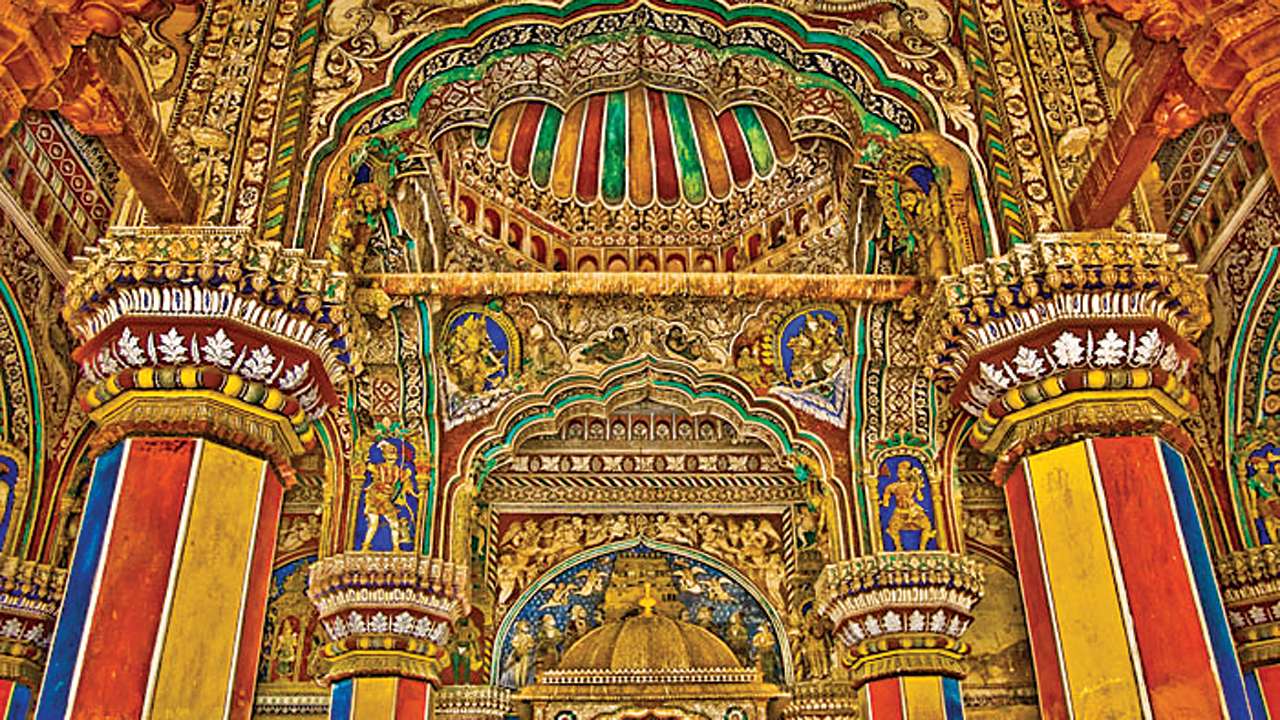
The Vijayanagar Empire was decisively defeated by the Deccan Sultanates in the Battle of Talikota, in 1565 C.E. The empire soon unravelled when many provincial governors, called Nayakas, declared independence one by one. Even before the last emperor died the Nayakas were at each other’s throats, making opportunistic alliances, and seeking the support of Europeans and even the Sultanates. Thanjavur and Madurai, once key constituents of the empire, engaged in a protracted and destructive conflict which eventually doomed both ruling dynasties.
The reasons behind the rivalry were many. Thanjavur Nayakas hailed from a noble house which strongly supported Vijayanagar even during the empire’s terminal decline. The Madurai Nayakas were of humbler origins and had changed colours right after Talikota. In 1614 CE, Madurai sided with a usurper who murdered the Vijayanagar emperor and his family. By 1659 Madurai’s expansionist activities led to the Sultanates annexing any remaining Vijayanagar crownlands: this reduced the last emperor to a refugee. Such actions also led to the Thanjavur kingdom losing lands to the Sultanates. Madurai’s alliance with the Sultans enabled roving Deccani Muslim warlords to quickly gain power in Tamil lands. Legends also say that a Madurai Nayaka murdered his bride, a Thanjavur princess (who was offered as a token of peace), in a moment of rage. The feud grew over the years — interspersed with very brief alliances of convenience — and reached a climax in 1673 CE.
Thanjavur was then ruled by the ageing Vijaya Raghava Nayaka. He was a patron of the arts and had written numerous poems and dramatic works. However, he believed in hoary notions of tradition, valour and honour — he even refused to modernise his army with firearms. The ruler of Madurai was the young Chokkanatha Nayaka. He had actually attempted to check the growing power of the Sultanates and the warlords but failed. In 1673 Chokkanatha requested the Thanjavur princess’s hand in marriage. The Thanjavur king contemptuously refused; the enraged Chokkanatha ordered his generals to capture the princess. Madurai’s army consisting of Deccani cavalry, musketeers, cannons and European mercenaries simply outclassed Thanjavur’s army. The Thanjavur fort was breached after heavy fighting; despite multiple offers of lenient terms, Vijaya Raghava resolved to “die with honour”. The royal palace was rigged with gunpowder and incendiaries and the royal womenfolk were herded into it. As the defenders sallied out and fought to the death, they blew up the palace, killing everyone inside.
Chokkanatha installed his brother Alagiri as a viceroy. However, Chengamaladas, a minor son of the fallen Thanjavur king, had escaped the carnage.
Chengamaladas later surfaced in Bijapur and requested the Sultan’s aid. In 1675 CE, the Sultan sent his general Venkoji, half-brother of Chhatrapati Shivaji, to reclaim Thanjavur for Chengamaladas (Ironically, Venkoji and his Maratha troops served Bijapur while Shivaji was invading it in the north). It was an opportune moment as Alagiri and Chokkanatha were now at war with each other. Thanjavur was conquered by the Marathas in a short campaign.
However, heeding to a prophetic dream (and perhaps sensing the Bijapur Sultanate’s impending end) Venkoji crowned himself King of Thanjavur in 1676. With Chengamaladas fleeing into obscurity the rule of the Thanjavur Nayakas ended.
Meanwhile in Madurai, rebellions and Chokkanatha’s plummeting popularity weakened the kingdom. The expansionist Thanjavur Marathas now began to prey on Madurai. Chokkanatha was deposed by the Madurai nobles and another brother was enthroned. In 1680, a powerful Deccani warlord named Rustam Khan captured power, chasing away the new Nayaka and installing Chokkanatha as a puppet ruler. Rustam Khan’s power grew alarmingly and he apparently began to forcibly claim women from the royal families. In 1682 Chokkanatha Nayaka’s heart finally gave out when Madurai was repeatedly invaded by her neighbours, and subsequently betrayed by her feudatories.
The Madurai kingdom was totally devastated at this point. Chokkanatha’s teenaged son Rangakrishna managed to reclaim some glory but he died of smallpox just seven years into his reign. Queen Mother Mangammal became the Regent for the next fifteen years as Rangakrishna’s heir was an infant. Mangammal’s brilliant leadership bought Madurai back from the brink. Using diplomacy, stratagems and military might, she eliminated threats and rebuilt Madurai’s power. However, after her death in 1705 the kingdom went into decline again. Madurai was slowly worn down by civil strife, and the campaigns of Thanjavur, Mysore and the Nawab of Arcot. In 1736, Arcot forces under Chanda Sahib ended centuries of Nayaka rule.
Madurai was subsequently tossed between various belligerents till the British became her overlord in 1764. The Marathas of Thanjavur fared slightly better. In 1855, Thanjavur lapsed into British rule when the last Maratha king died without a natural heir.
The author, an IIM Ahmedabad graduate working in the energy sector, has a keen interest in history, politics, and strategic affairs
source: http://www.dnaindia.com / DNA / Home> Analysis / by Ananth Karthikeyan / April 08th, 2018